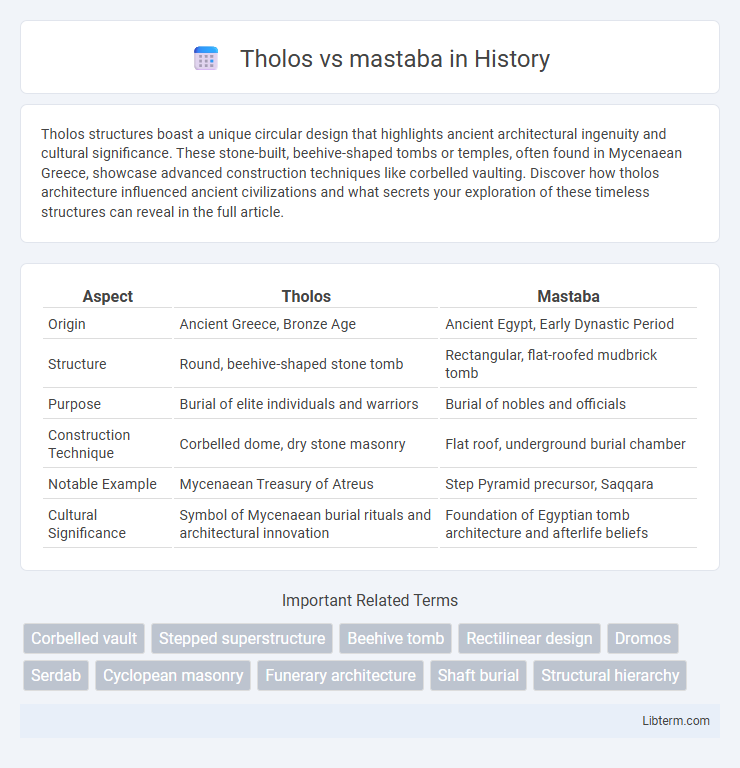Tholos structures boast a unique circular design that highlights ancient architectural ingenuity and cultural significance. These stone-built, beehive-shaped tombs or temples, often found in Mycenaean Greece, showcase advanced construction techniques like corbelled vaulting. Discover how tholos architecture influenced ancient civilizations and what secrets your exploration of these timeless structures can reveal in the full article.
Table of Comparison
| Aspect | Tholos | Mastaba |
|---|---|---|
| Origin | Ancient Greece, Bronze Age | Ancient Egypt, Early Dynastic Period |
| Structure | Round, beehive-shaped stone tomb | Rectangular, flat-roofed mudbrick tomb |
| Purpose | Burial of elite individuals and warriors | Burial of nobles and officials |
| Construction Technique | Corbelled dome, dry stone masonry | Flat roof, underground burial chamber |
| Notable Example | Mycenaean Treasury of Atreus | Step Pyramid precursor, Saqqara |
| Cultural Significance | Symbol of Mycenaean burial rituals and architectural innovation | Foundation of Egyptian tomb architecture and afterlife beliefs |
Introduction to Tholos and Mastaba
Tholos and mastaba are ancient architectural structures used for burial purposes, with tholos originating in Mycenaean Greece and mastaba in ancient Egypt. Tholos, also known as a beehive tomb, features a circular design with a corbelled roof, showcasing advanced masonry techniques. In contrast, mastabas are flat-roofed, rectangular tombs made of mudbrick or stone, serving as early Egyptian burial chambers before the development of pyramids.
Historical Origins of Tholos and Mastaba
Tholos tombs originated in the ancient Aegean civilization, particularly in Mycenae around 1500 BCE, characterized by their beehive-shaped, circular stone structures used for elite burials. Mastabas, emerging in ancient Egypt around 3000 BCE during the Early Dynastic Period, were rectangular, flat-roofed tombs with sloping sides, serving as burial sites for nobles and officials. These distinct architectural forms reflect the differing cultural and religious practices of the Mycenaean Greeks and ancient Egyptians in honoring their dead.
Architectural Design Comparison
Tholos tombs feature circular, beehive-shaped structures with corbelled stone roofs, emphasizing vertical height and interior space optimization. Mastabas are rectangular, flat-roofed, mudbrick or stone tombs with sloping sides, designed to provide a solid, stable platform for burial chambers underground. Tholos design prioritizes monumental appearance and complex stone masonry, while mastabas emphasize functional simplicity and ease of construction.
Cultural Significance of Tholos and Mastaba
The Tholos tomb reflects ancient Greek architectural innovation, symbolizing prestigious burial practices linked to status and religious beliefs in the Mycenaean civilization, emphasizing circular, domed structures for elite interments. Mastabas, prominent in early Egyptian culture, represent the foundation of tomb architecture with rectangular, flat-roofed forms that served as burial sites for nobility, illustrating early concepts of the afterlife and ancestral veneration. Both structures reveal distinct cultural attitudes towards death, spirituality, and social hierarchy in their respective societies.
Construction Techniques and Materials
Tholos tombs, characterized by their circular design, were constructed using corbelled stone masonry, creating a beehive-shaped interior without the need for wooden supports. Mastabas featured a rectangular, flat-roofed structure built from mud bricks or stone blocks, with sloping sides and a subterranean burial chamber accessed via vertical shafts. The advanced corbelling technique in tholos tombs allowed for large, open interior spaces, while mastabas relied on simpler, stacked masonry techniques suitable for early Egyptian burial practices.
Geographic Distribution and Examples
Tholos tombs are primarily found in the Aegean region, especially in Mycenae and other parts of ancient Greece, serving as beehive-shaped burial chambers for elite individuals during the Bronze Age. Mastabas, in contrast, are characteristic of ancient Egypt, particularly along the Nile River valley, functioning as flat-roofed, rectangular tomb structures built for nobility and officials in the Early Dynastic period and Old Kingdom. Notable examples include the Treasury of Atreus, a famous Mycenaean tholos tomb, and the Mastaba of Ti, an important Egyptian mastaba located in Saqqara.
Burial Practices: Tholos vs Mastaba
Tholos tombs, prominent in Mycenaean Greece, feature a beehive-shaped structure with corbelled stone roofs, designed for elite burials and often containing rich grave goods symbolizing status and power. Mastabas, originating in ancient Egypt, are rectangular, flat-roofed tombs constructed from mud-bricks, serving as underground burial chambers for nobility and high officials, emphasizing provisions for the afterlife with offering chapels and false doors. Both burial practices reflect distinct cultural attitudes toward death and the afterlife, with Tholos emphasizing monumental architecture for collective elite burials and mastabas focusing on individualized tombs ensuring eternal sustenance in the Egyptian tradition.
Symbolism and Artistic Elements
Tholos tombs symbolize continuity and eternity with their circular design, often associated with ancient Greek and Mycenaean cultures emphasizing an unbroken cycle of life and death. Mastabas, with their rectangular shape and flat tops, represent stability and groundedness, characteristic of early Egyptian burial practices focused on eternal rest and protection. Artistic elements in tholos tombs highlight intricate stone masonry and corbelled domes, while mastabas feature decorated chapels and false doors symbolizing the soul's journey.
Influence on Later Burial Architecture
Tholos tombs, characterized by their circular, beehive-shaped structure and corbelled roofs, influenced later burial architecture by inspiring the development of monumental stone-built tombs in Mycenaean and Minoan cultures. Mastabas, with their flat-roofed, rectangular forms and subterranean burial chambers, served as architectural precursors to the Egyptian stepped pyramids and influenced subsequent Old Kingdom tomb designs. The contrasting forms of tholos and mastaba underscore a shift from subterranean to above-ground monumental burial practices that shaped ancient funerary architecture.
Tholos and Mastaba: Legacy and Modern Interpretations
Tholos tombs, characterized by their beehive-shaped stone structures, symbolize advanced architectural innovation in ancient Greece, influencing modern circular design and archaeological studies. Mastabas, rectangular flat-roofed tombs from ancient Egypt, serve as precursors to the step pyramid, reflecting early concepts of funerary architecture that continue to inform contemporary understandings of burial practices. Both structures offer critical insights into cultural ritual evolution, shaping modern interpretations of ancient societies' social hierarchies and spiritual beliefs.
Tholos Infographic

 libterm.com
libterm.com